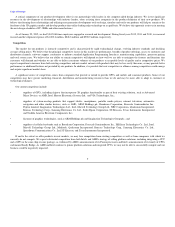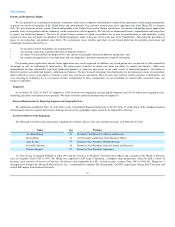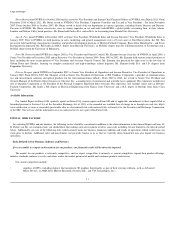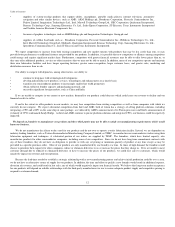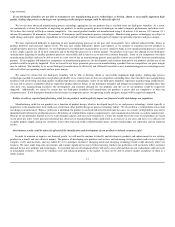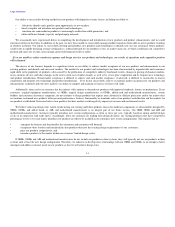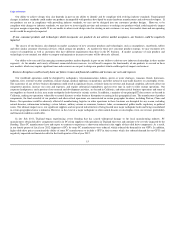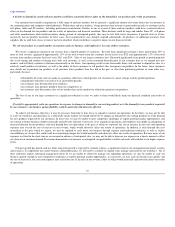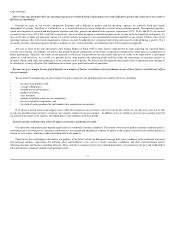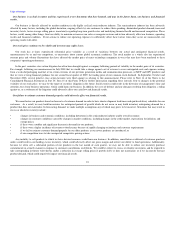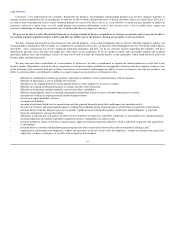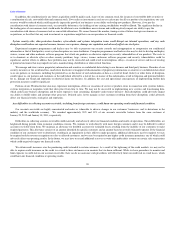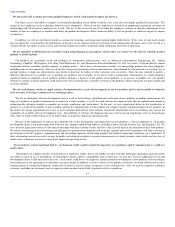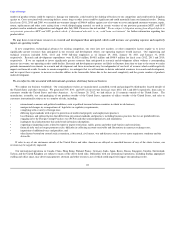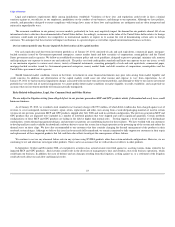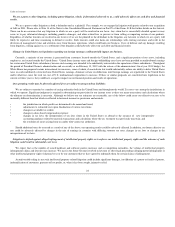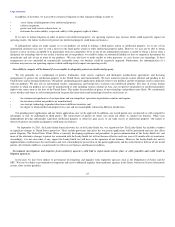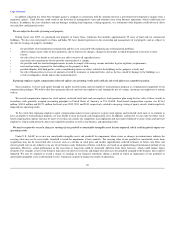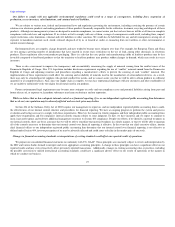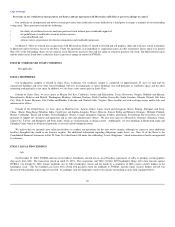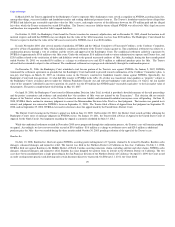NVIDIA 2012 Annual Report Download - page 20
Download and view the complete annual report
Please find page 20 of the 2012 NVIDIA annual report below. You can navigate through the pages in the report by either clicking on the pages listed below, or by using the keyword search tool below to find specific information within the annual report.
Table of Contents
Conversely, if we underestimate our customers' demand for our products, our third-party manufacturing partners may not have adequate lead-time or
capacity to increase production for us meaning that we may not be able to obtain sufficient inventory to fill our customers' orders on a timely basis. Even if we
are able to increase production levels to meet customer demand, we may not be able to do so in a cost effective or timely manner. Inability to fulfill our
customers' orders on a timely basis, or at all, could damage our customer relationships, result in lost revenue, cause a loss in market share, impact our
customer relationships or damage our reputation, any of which could adversely impact our business.
We may not be able to realize the potential financial or strategic benefits of business acquisitions or strategic investments and we may not be able to
successfully integrate acquisition targets, which could hurt our ability to grow our business, develop new products or sell our products.
We have acquired and invested in other businesses that offered products, services and technologies that we believe will help expand or enhance our
existing products and business. Most recently, we completed our acquisition of Icera Inc., an innovator of baseband processors for 3G and 4G cellular phones
and tablets. Such a transaction can involve significant integration challenges and there can be no assurance that pre-acquisition due diligence will have
identified all possible issues and risks that might arise with respect to the acquisition. If we are unable to timely and successfully integrate the acquired
operations, product lines and technology of Icera, we may not be able to realize the expected benefits of the acquisition, which could adversely affect our
business plans and operating results.
We may enter into future acquisitions of, or investments in, businesses, in order to complement or expand our current businesses or enter into a new
business market. Negotiations associated with an acquisition or strategic investment could divert management's attention and other company resources. Any
of the following risks associated with past or future acquisitions or investments could impair our ability to grow our business, develop new products, our
ability to sell our products, and ultimately could have a negative impact on our growth or our financial results:
• difficulty in combining the technology, products, operations or workforce of the acquired business with our business;
• difficulty in operating in a new or multiple new locations;
• disruption of our ongoing businesses or the ongoing business of the company we invest in or acquire;
• difficulty in realizing the potential financial or strategic benefits of the transaction;
• difficulty in maintaining uniform standards, controls, procedures and policies;
• difficulty integrating the target's accounting, management information, human resources and other administrative systems;
• disruption of or delays in ongoing research and development efforts;
• diversion of capital and other resources;
• assumption of liabilities;
• incurring acquisition-related costs or amortization costs for acquired intangible assets that could impact our operating results;
• diversion of resources and unanticipated expenses resulting from litigation arising from potential or actual business acquisitions or investments;
• potential failure of the due diligence processes to identify significant issues with product quality, architecture and development, or legal and
financial contingencies, among other things;
• difficulties in entering into new markets in which we have limited or no experience and where competitors in such markets have stronger positions;
• incurring significant exit charges if products acquired in business combinations are unsuccessful;
• potential inability to obtain, or obtain in a timely manner, approvals from governmental authorities, which could delay or prevent such acquisitions
or investments;
• potential delay in customer and distributor purchasing decisions due to uncertainty about the direction of our product offerings; and
• impairment of relationships with employees, vendors and customers, or the loss of any of our key employees, vendors or customers our target's key
employees, vendors or customers, as a result of our acquisition or investment.
19


